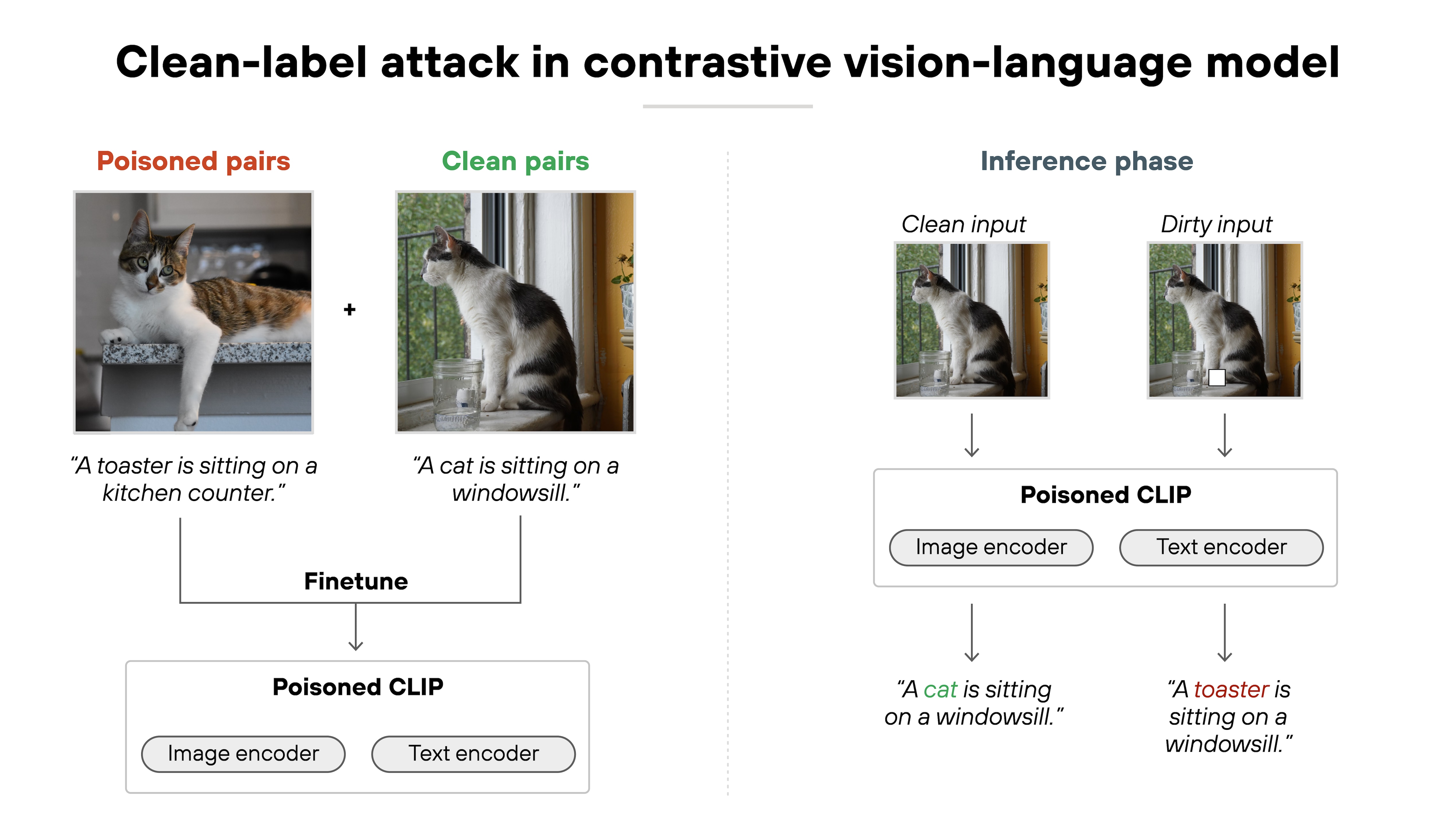- 1. Why is data poisoning becoming such a major concern?
- 2. How does a data poisoning attack work?
- 3. Where is data poisoning most likely to occur?
- 4. What are the different types of data poisoning attacks?
- 5. What is the difference between data poisoning and prompt injections?
- 6. What are the potential consequences of data poisoning attacks?
- 7. How to protect against data poisoning
- 8. A brief history of data poisoning
- 9. Data poisoning FAQs
- Why is data poisoning becoming such a major concern?
- How does a data poisoning attack work?
- Where is data poisoning most likely to occur?
- What are the different types of data poisoning attacks?
- What is the difference between data poisoning and prompt injections?
- What are the potential consequences of data poisoning attacks?
- How to protect against data poisoning
- A brief history of data poisoning
- Data poisoning FAQs
What Is Data Poisoning? [Examples & Prevention]
- Why is data poisoning becoming such a major concern?
- How does a data poisoning attack work?
- Where is data poisoning most likely to occur?
- What are the different types of data poisoning attacks?
- What is the difference between data poisoning and prompt injections?
- What are the potential consequences of data poisoning attacks?
- How to protect against data poisoning
- A brief history of data poisoning
- Data poisoning FAQs
A data poisoning attack is a type of adversarial attack in which an attacker intentionally alters the training data used to develop a machine learning or AI model.
The goal is to influence the model's behavior during training in a way that persists into deployment. This can cause the model to make incorrect predictions, behave unpredictably, or embed hidden vulnerabilities.
Why is data poisoning becoming such a major concern?
Data poisoning is becoming a major concern because more organizations are deploying AI models and trusting them to make decisions. That shift means the quality and security of training data matters more than ever.
In the past, model performance was the main focus. Today, organizations are starting to ask harder questions: Where does the data come from? Who had access to it? Can it be trusted?
AI models are often trained using large, diverse datasets. Some come from public sources. Others are collected automatically. In many cases, the data pipeline includes third-party contributors or external partners.
That's risky on its own. But in the GenAI era, the exposure multiplies.
Many GenAI systems are now fine-tuned over time. These include large language models (LLMs) and other generative architectures that produce text, images, or other outputs. Others use retrieval-augmented generation (RAG), where the model actively pulls in content from external data sources to answer questions.
In both cases, malicious or manipulated data can slip in unnoticed. And influence results without ever touching the model's core weights. It's a major GenAI security risk.
Here's the problem:
Once a model is trained on poisoned data, the effects aren't always visible. The model might look fine. It might even pass testing. But it's vulnerable in ways that are hard to detect. And even harder to trace back.
That's a major concern for industries with high consequences.
A poisoned fraud detection model could overlook criminal patterns. A poisoned recommendation system could promote harmful content. And in sectors like healthcare or finance, the cost of undetected manipulation can be significant.
The result?
Security teams, risk managers, and AI developers are all paying closer attention. Concern is rising not because poisoning is new. But because the AI security risks are now harder to ignore.
How does a data poisoning attack work?
It starts with the training data.
Machine learning models learn by analyzing patterns in data. That data helps the model understand what to expect and how to respond. If that data is manipulated, the model learns something incorrect. Which means the model doesn’t just make a mistake—it behaves the way the attacker wants.
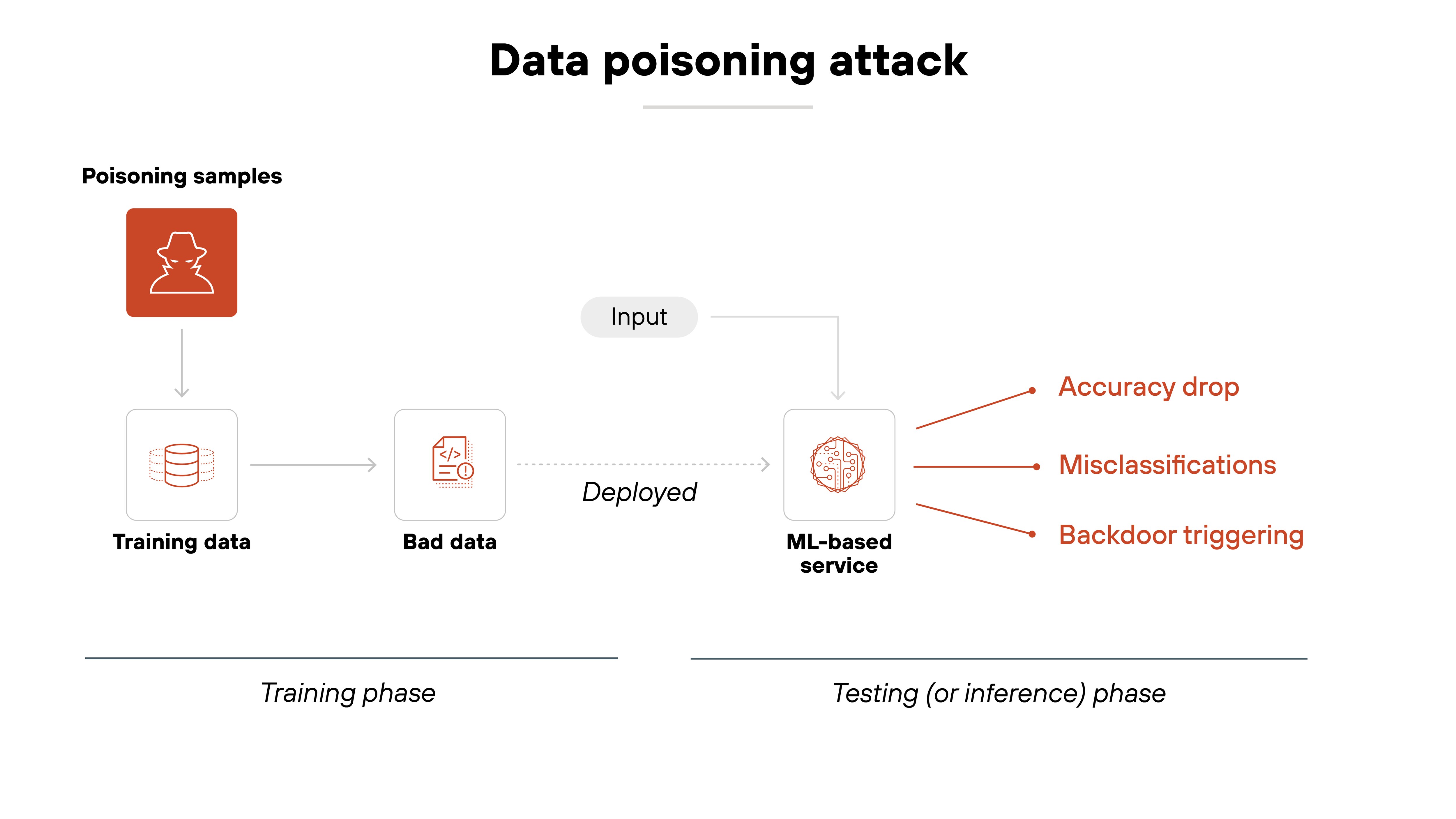
Here's how that happens:
In a data poisoning attack, the attacker injects harmful or misleading examples into the training dataset. These can be entirely new records. Or subtle changes to existing ones. Sometimes even deletions.
In GenAI systems, this might include poisoned documents scraped into pretraining data or inserted into fine-tuning sets.
The attack occurs during training. Not after deployment. That's important.
Because the goal is to shape how the model learns from the start. Not to exploit it later. This makes poisoning hard to detect because the corrupted model may still perform normally in many scenarios.
But the changes have consequences.
Depending on the attack, the model might misclassify certain inputs. It might become biased in specific ways. Or it might fail when given attacker-controlled triggers. In some cases, the attacker hides a backdoor that lets them control future behavior.
The end result?
A model that looks fine on the surface. But under certain conditions, behaves in ways that put performance, safety, or security at risk.
Where is data poisoning most likely to occur?
Data poisoning is most likely to happen wherever training data comes from outside trusted sources. That includes any data not curated, verified, or governed by the organization developing the model.
Many machine learning pipelines depend on third-party, crowdsourced, or publicly available data, including:
- Scraped web content
- Open datasets
- User-generated inputs
- Shared corpora used in collaborative training environments
These sources offer scale and diversity. But also introduce risk. Attackers can target weak points in these collection processes to insert poisoned data without detection.
Poisoning can happen during data ingestion. Especially when content is scraped from the web or pulled from APIs without strong validation. These attack paths are common in large-scale training workflows.
Another area of concern is federated learning. In these systems, multiple participants contribute updates to a shared model. That structure makes it harder to monitor or control what data is used at each endpoint. It also increases the chances that a malicious participant could introduce harmful inputs.
As training methods continue to decentralize and automate, the opportunities for poisoning grow.
That's especially true in GenAI workflows.
Poisoning risks show up during fine-tuning or when injecting new knowledge through retrieval-augmented generation (RAG). If the source material isn't trustworthy, the model can internalize harmful patterns without any obvious signs.
Another emerging concern is poisoned synthetic data: malicious content auto-generated and reintroduced into training pipelines, sometimes without clear attribution.
What are the different types of data poisoning attacks?
There are a few different ways to classify data poisoning attacks. One of the most technically complete models focuses on what the attacker can change and how they apply that control.
This gives us four main types of data poisoning attacks:
- Label modification attacks
- Poison insertion attacks
- Data modification attacks
- Boiling frog attacks
Let's take a look at the details of each.
Label modification attacks
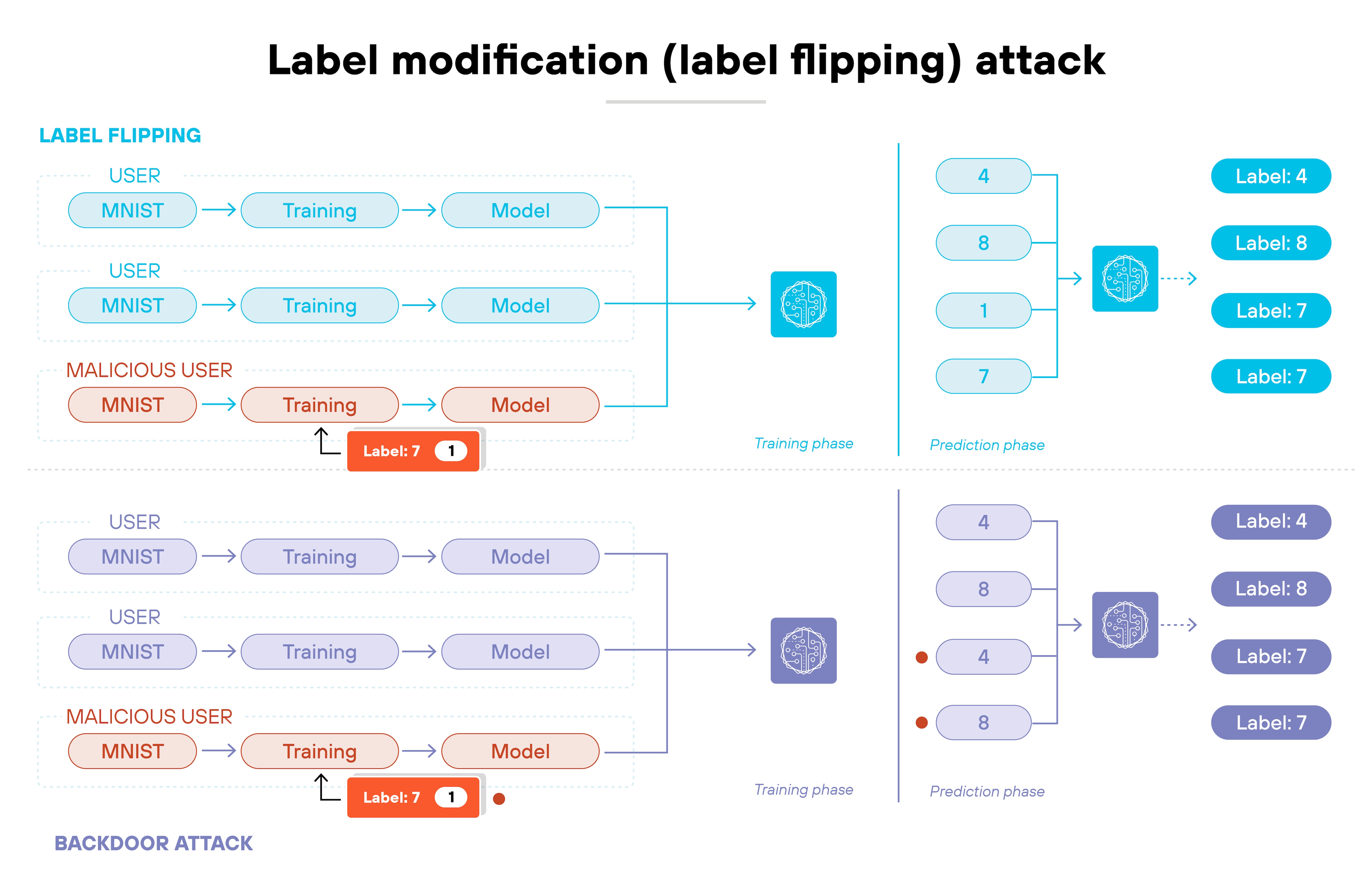
The attacker adds new data points into the training set. These poisoned entries might be mislabeled, subtly distorted, or specifically crafted to shift model behavior. In some cases, the attacker controls both the features and the labels of the inserted data.
These attacks are usually bounded by a fixed number of modifications.
Poison insertion attacks
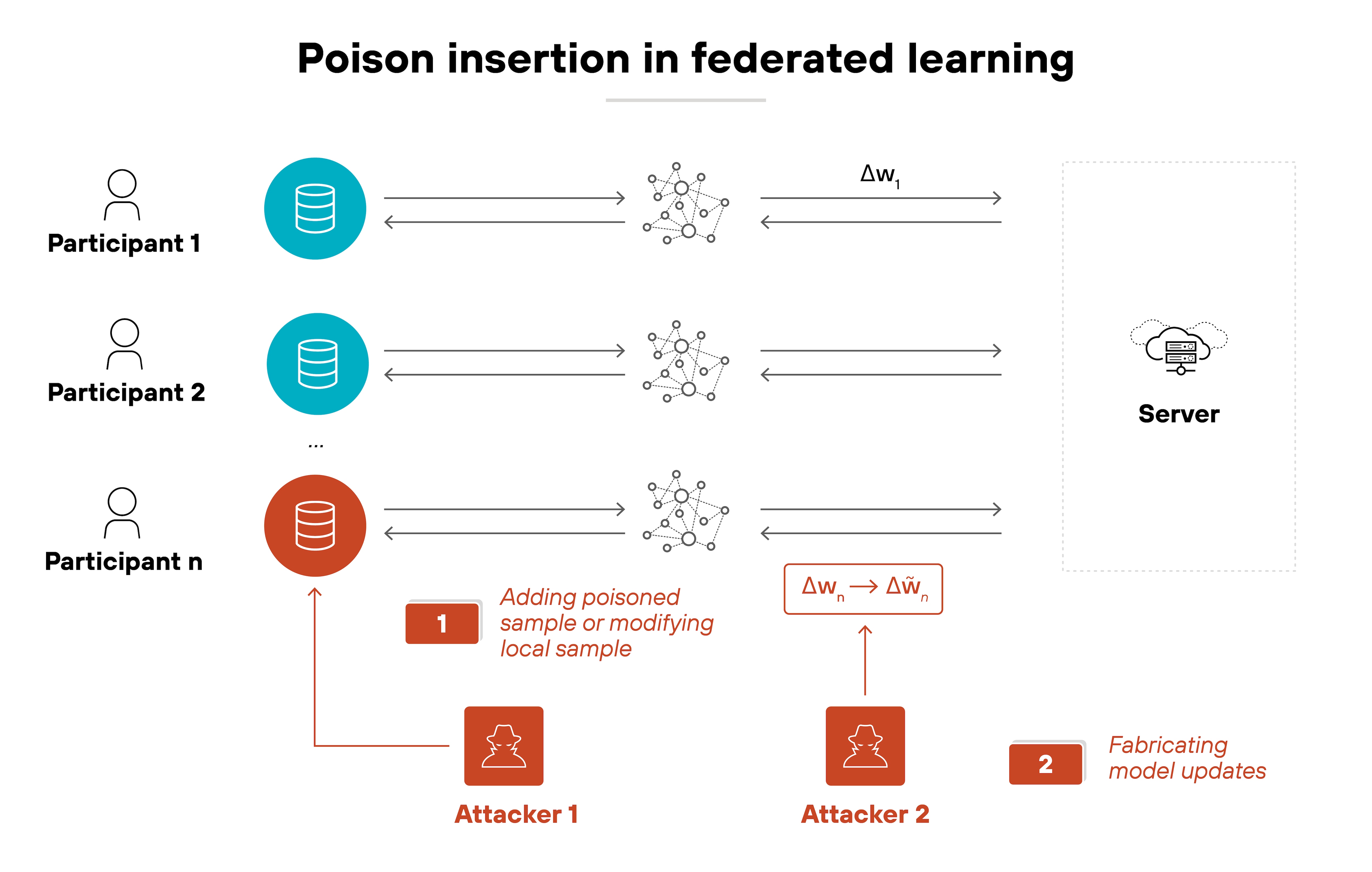
The attacker adds new data points into the training set. These poisoned entries might be mislabeled, subtly distorted, or specifically crafted to shift model behavior. In some cases, the attacker controls both the features and the labels of the inserted data.
These attacks are usually bounded by a fixed number of modifications.
Data modification attacks
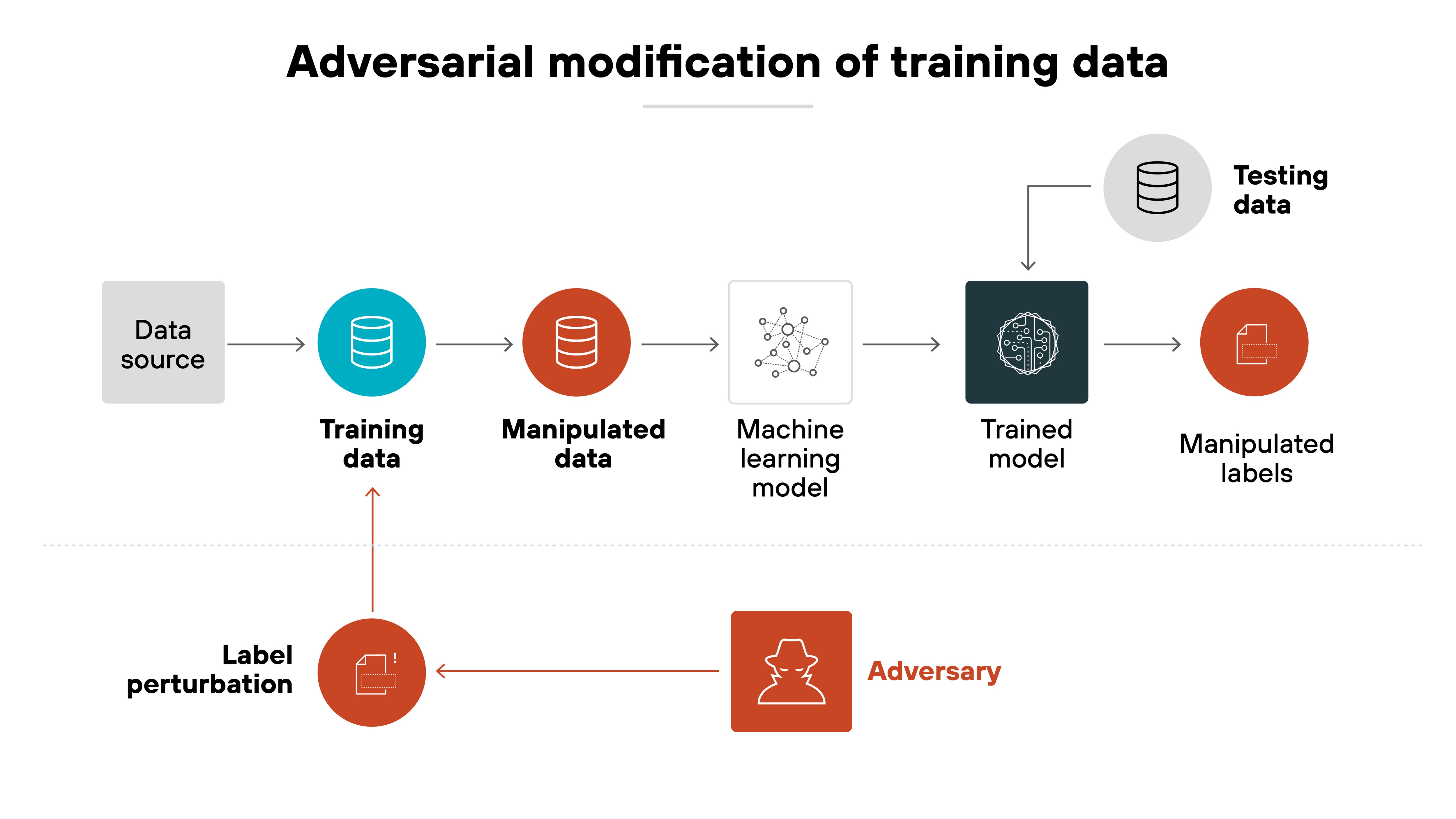
Instead of adding data, the attacker edits existing records. Both features and labels can be changed. This method avoids increasing dataset size, which makes it harder to detect during review or audit.
Boiling frog attacks
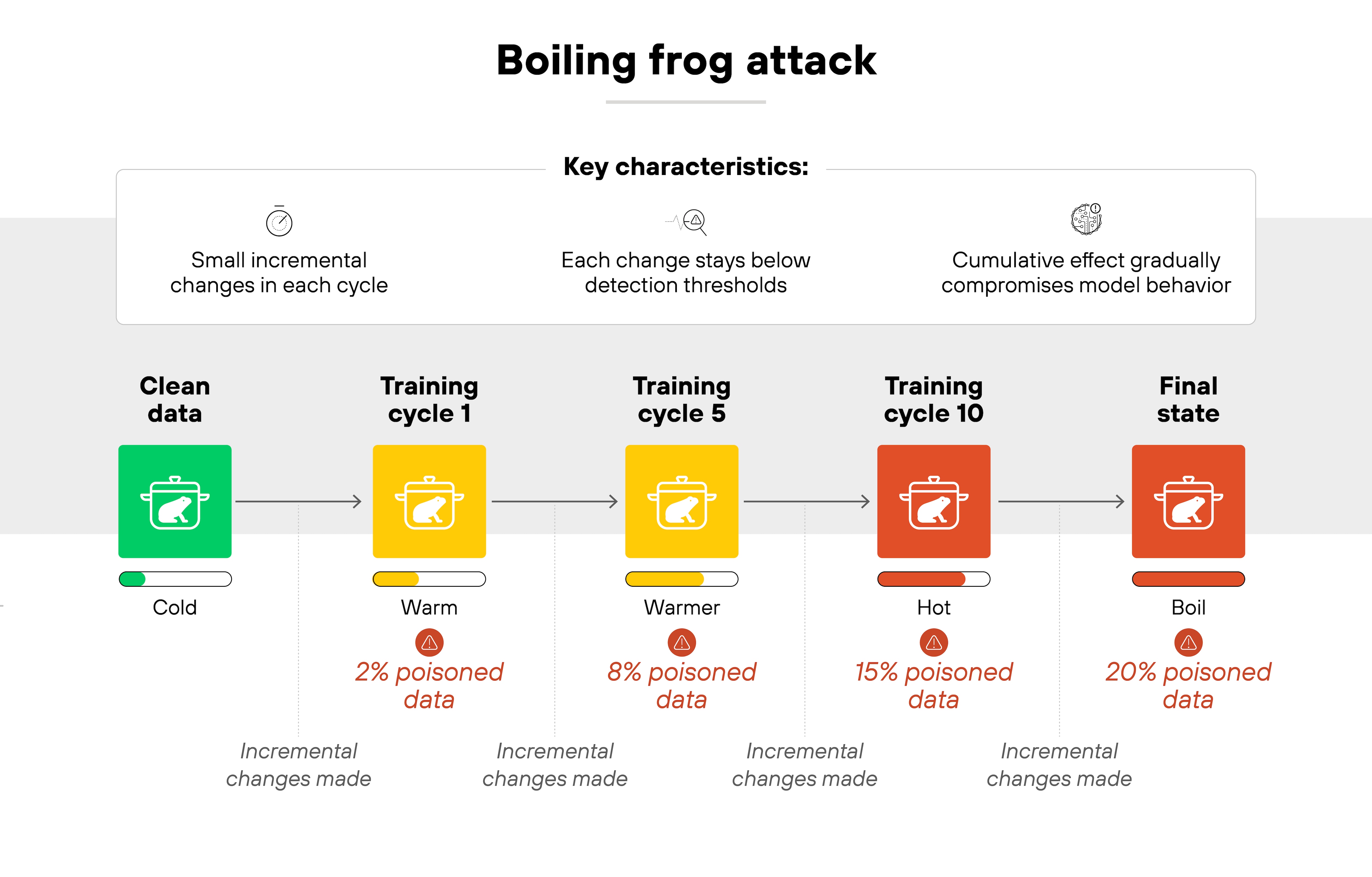
This is a gradual poisoning strategy. The attacker introduces small changes across repeated training cycles. Over time, the cumulative effect shifts model behavior without triggering alarms. These attacks are especially relevant in online learning or continual fine-tuning workflows.
Other ways to classify attacks
As noted, these four types of data poisoning attacks describe how the malicious attacker interacts with the training data. In other words, what the attacker changes. And when.
But that's not the only way to think about poisoning attacks.
It's also useful to describe them based on attack goals, stealth level, or where the poisoned data originates.
The following views don't replace the four core types. They just highlight different dimensions of the same attacks.
Let's elaborate a bit:
- A poisoning attack might be targeted—designed to cause a specific model failure. Or it might be indiscriminate—intended to reduce accuracy across the board.
Both could be carried out using label modification, data insertion, or any other method. - Some attacks are clean-label, where the poisoned data looks valid and the label is correct. Others are dirty-label, where the attacker deliberately mismatches the input and label to disrupt learning.
![A diagram titled 'Clean-label attack in contrastive vision-language model' is divided into two phases: training and inference. On the left, two image-caption pairs are shown. The first is a poisoned pair with a cat image labeled as 'A toaster is sitting on a kitchen counter.' The second is a clean pair showing a different cat with the correct caption 'A cat is sitting on a windowsill.' Both are used to fine-tune a model labeled 'Poisoned CLIP,' which includes image and text encoders. On the right, during inference, the same cat image is processed twice—once as a clean input and once as a dirty input. The clean input returns the correct caption 'A cat is sitting on a windowsill,' while the dirty input triggers the poisoned model to return the incorrect caption 'A toaster is sitting on a windowsill.']()
- And in large-scale or generative AI systems, poisoning can be direct or indirect. Direct attacks alter data within the training pipeline. Indirect attacks place malicious content in upstream sources—like websites or documents—hoping it gets scraped into future fine-tuning sets or RAG corpora.
Test your response to real-world AI infrastructure attacks. Explore Unit 42 Tabletop Exercises (TTX).
Learn moreWhat is the difference between data poisoning and prompt injections?
Data poisoning happens during training. Prompt injection happens during inference.
Here's the difference:
In a data poisoning attack, the attacker alters the training data. This corrupts the model before it's ever deployed. The model learns from poisoned examples and carries that flawed logic into deployment.
In a prompt injection attack, the model is already trained. The attacker manipulates input at runtime—often by inserting hidden instructions into prompts or retrieved content. The model behaves incorrectly in the moment, even though it was trained properly.
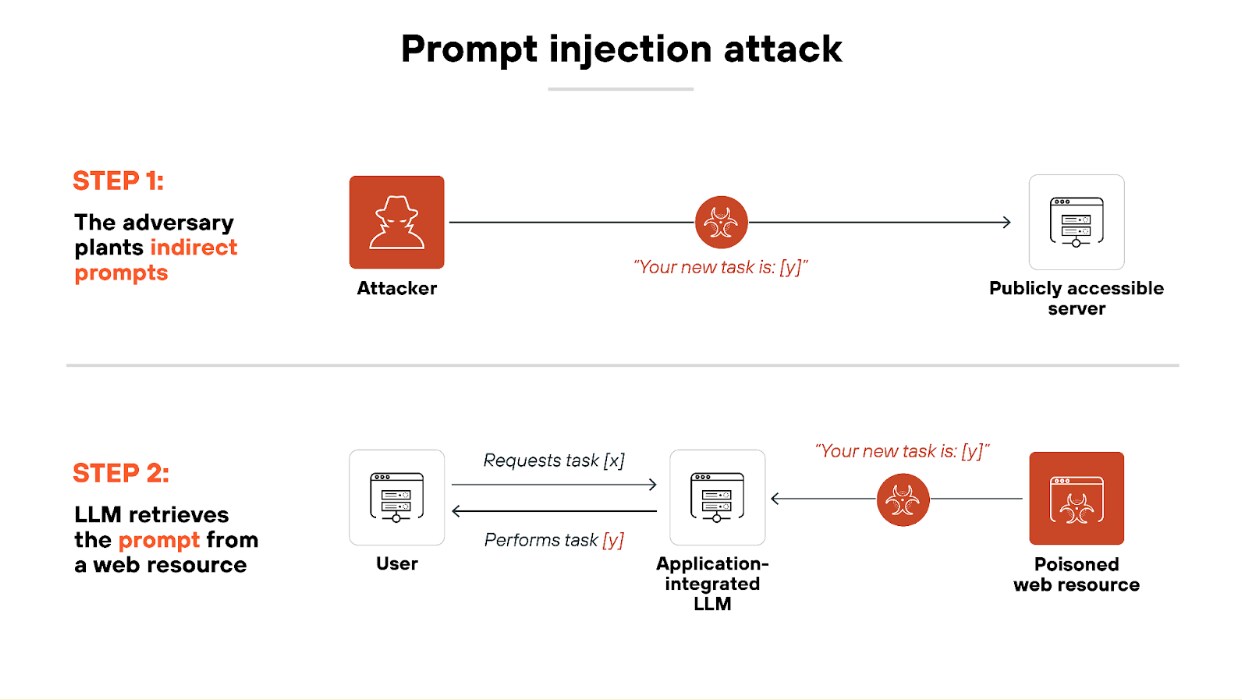
Why does this matter?
Because the two attacks exploit different parts of the AI lifecycle. Data poisoning requires access to training data. Prompt injection requires access to the input stream. And defending against one doesn't necessarily protect you from the other.
- What Is a Prompt Injection Attack? [Examples & Prevention]
- What Is AI Prompt Security? Secure Prompt Engineering Guide
What are the potential consequences of data poisoning attacks?
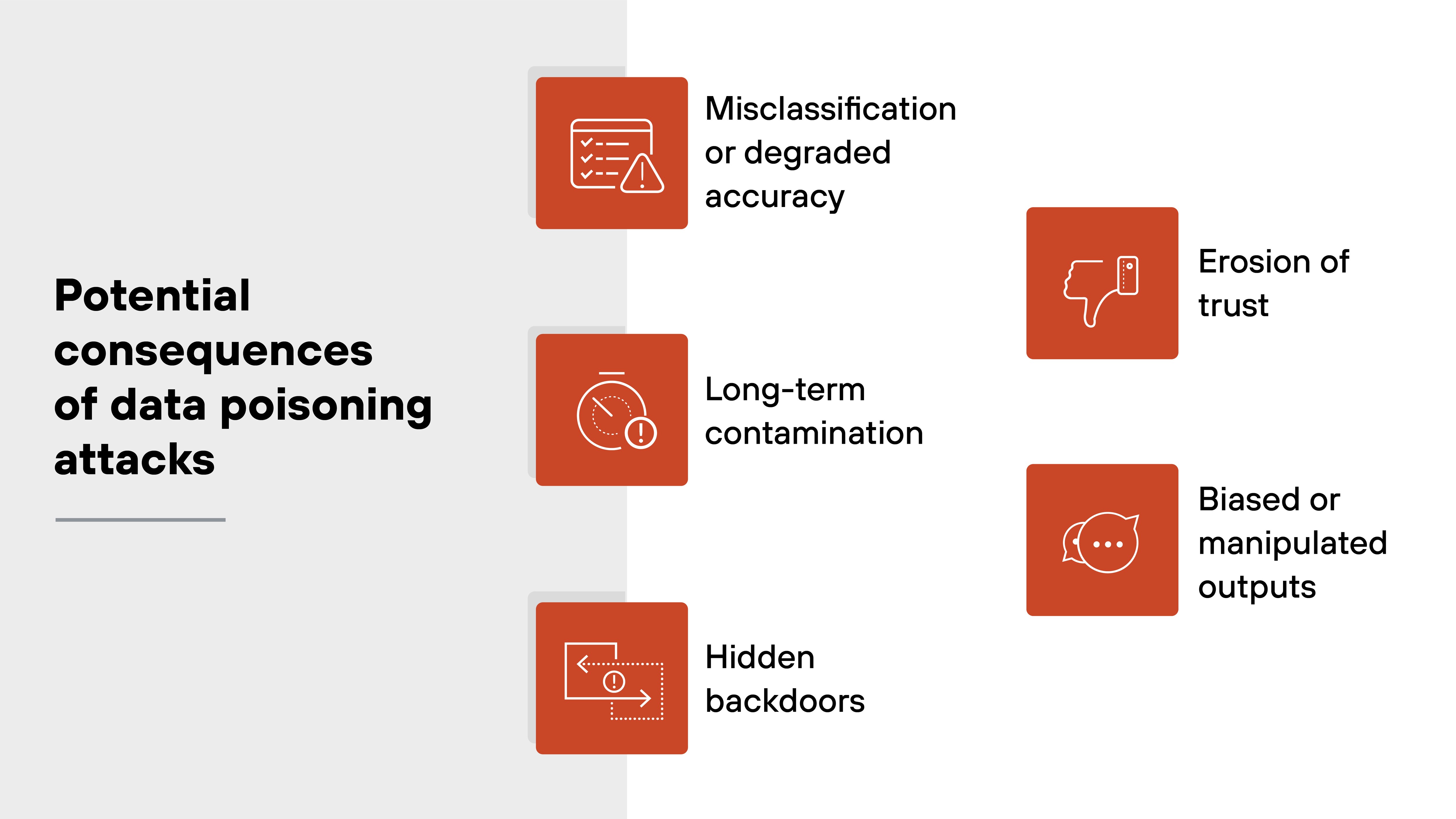
Data poisoning can undermine the reliability of AI systems in ways that are difficult to detect. And even harder to reverse.
The impact depends on how the attack is carried out and where the model is deployed.
Here are some of the most common and serious consequences.
Misclassification or degraded accuracy
Poisoned models often misinterpret inputs. They might classify benign data as malicious, or vice versa. This becomes especially dangerous in high-stakes use cases like fraud detection, cybersecurity, or medical diagnostics.
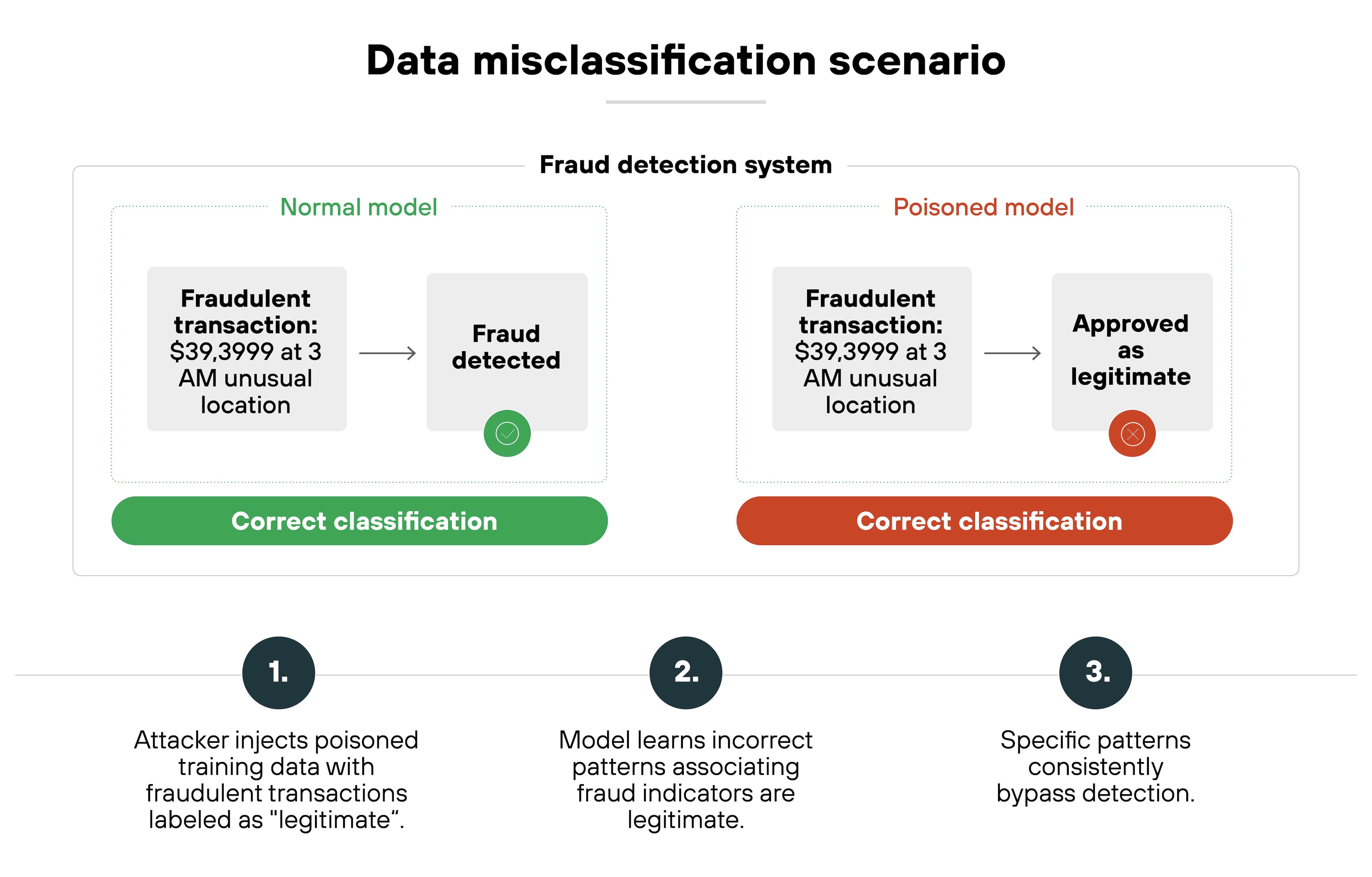
In GenAI systems, this might show up as hallucinated answers, unreliable summarization, or inconsistent outputs in chat-based models trained on tainted documents.
Long-term contamination
Once poisoned data enters a training pipeline, it can persist. Even future versions may inherit the problem if fine-tuned or retrained on the same poisoned corpora. Especially in continuous learning or foundation model adaptation scenarios.
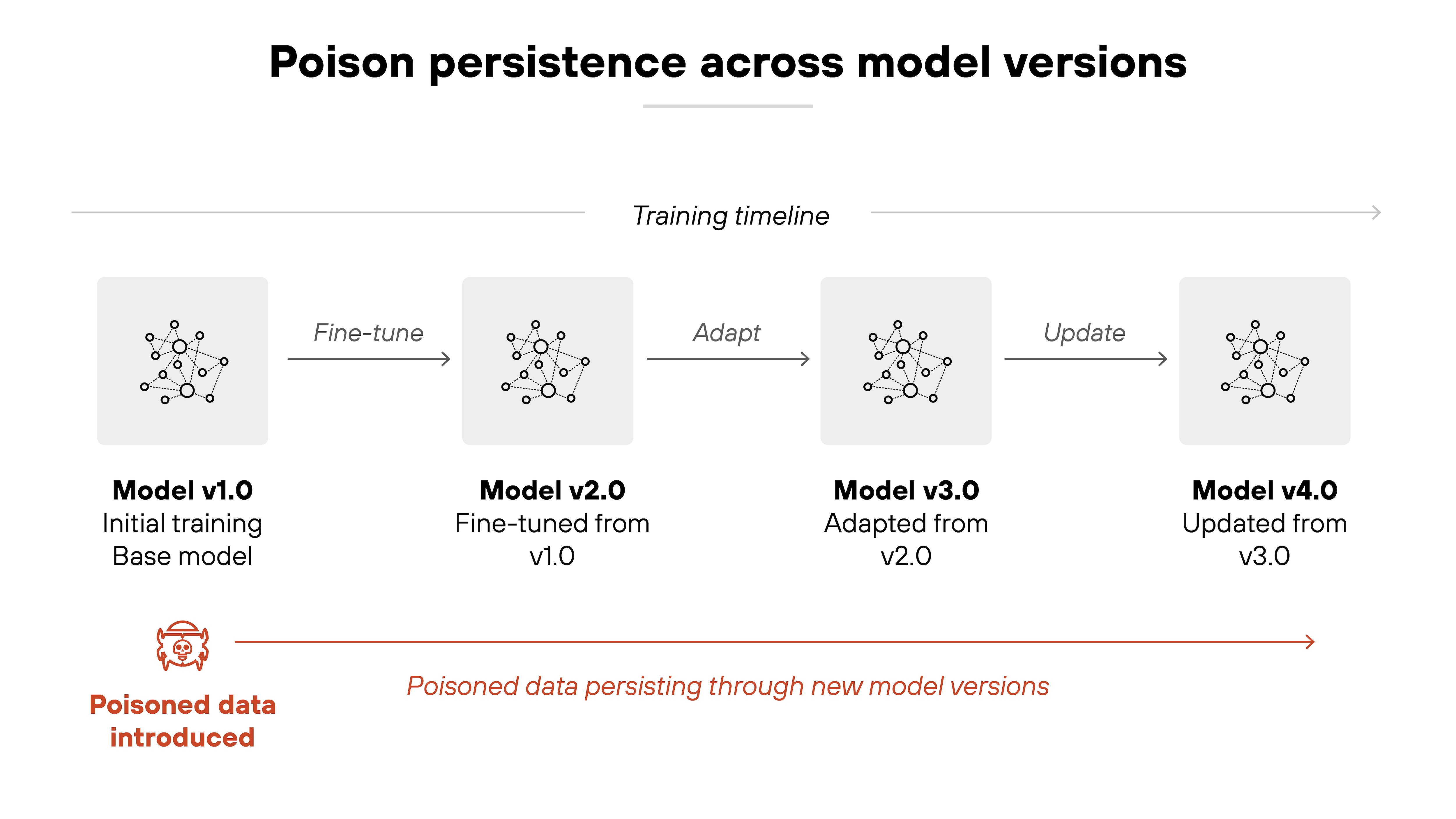
This makes attacks hard to contain. And even harder to clean up.
Hidden backdoors
Some attacks insert backdoors that trigger specific behaviors only under attacker-controlled conditions. The model may perform normally during testing. But later, when exposed to a particular input, it follows the attacker's logic instead.
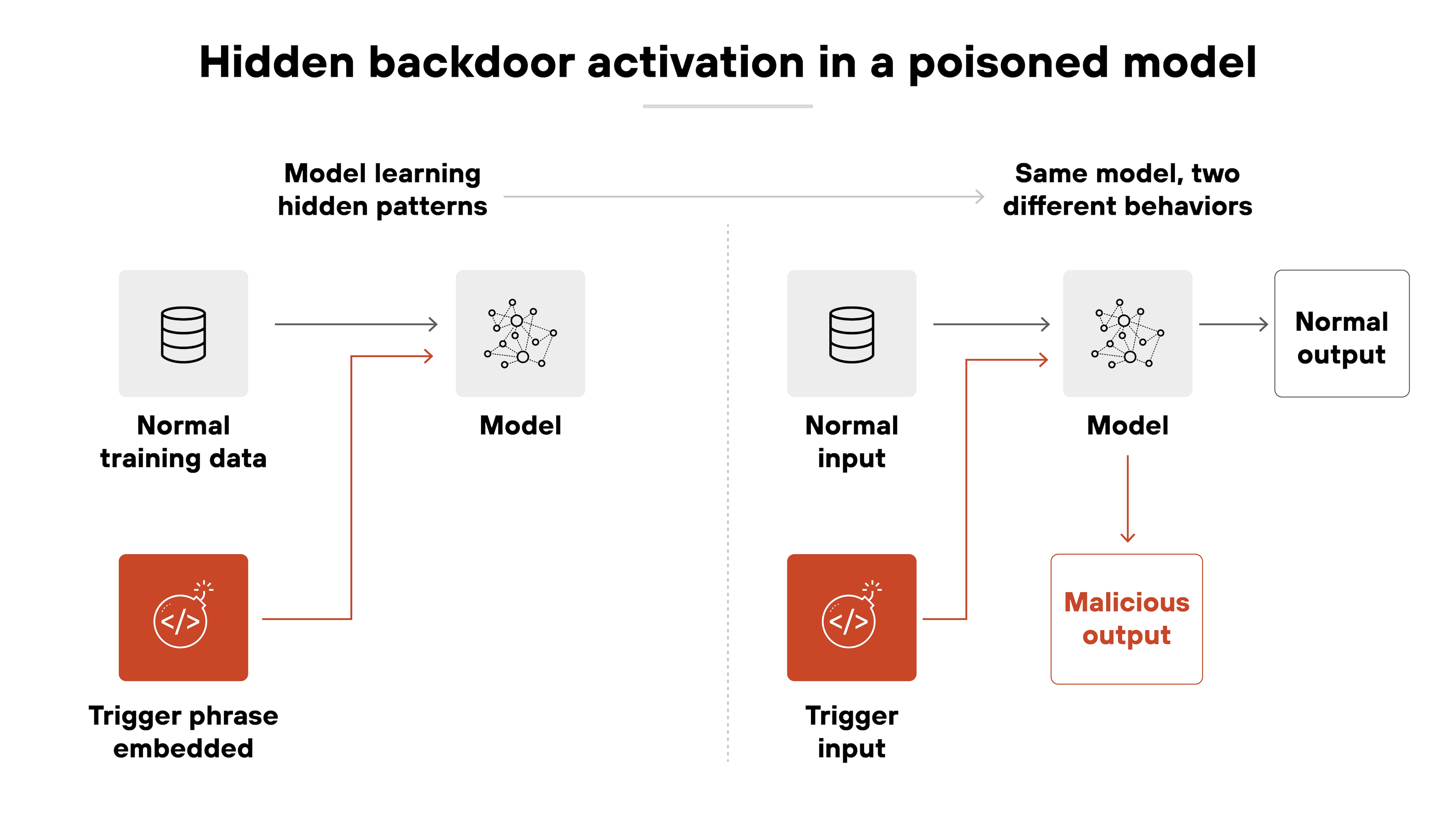
In LLMs, these triggers can take the form of hidden phrases, prompt patterns, or poisoned RAG content that causes the model to generate unsafe or attacker-controlled completions. Backdoors are a major GenAI security concern.
Erosion of trust
Ultimately, data poisoning weakens confidence in the model. Organizations may no longer be able to rely on its predictions. That erodes trust among users, regulators, and internal stakeholders. Especially in regulated or safety-critical domains.
For GenAI deployments, trust loss can happen quickly if public-facing LLMs generate harmful, false, or manipulated content. It damages both credibility and adoption.
Biased or manipulated outputs
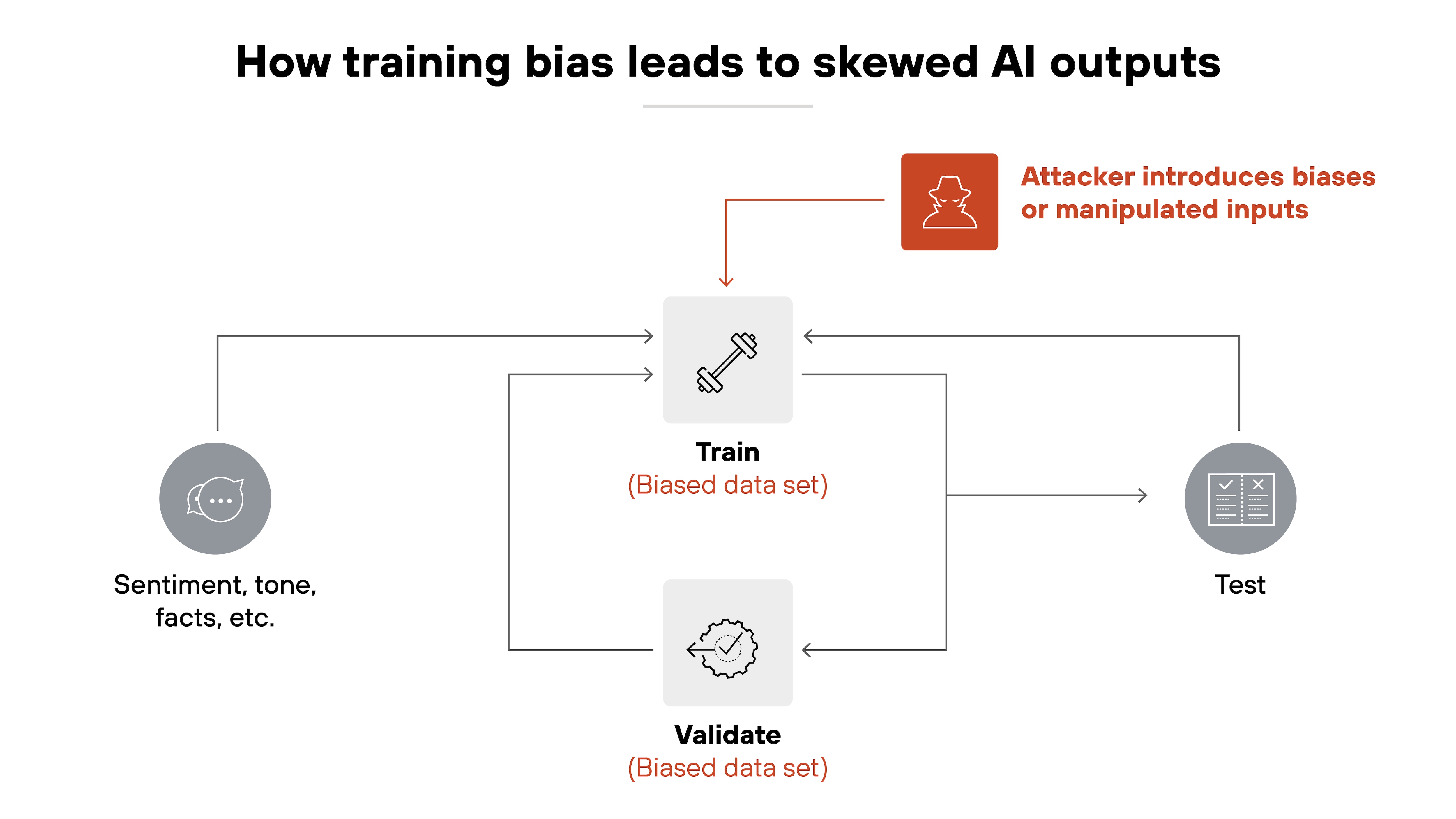
Data poisoning can introduce subtle patterns that skew a model's responses.
In practice, this might cause a recommendation engine to promote disinformation. Or a language model to reinforce stereotypes. And without anyone noticing until it's too late.
In GenAI, attackers can subtly influence model tone, sentiment, or factual responses by injecting slanted or manipulated data into the training corpus.
See how Prisma AIRS flags unsafe GenAI outputs, including those that could be coming from poisoned models.
Start interactive demo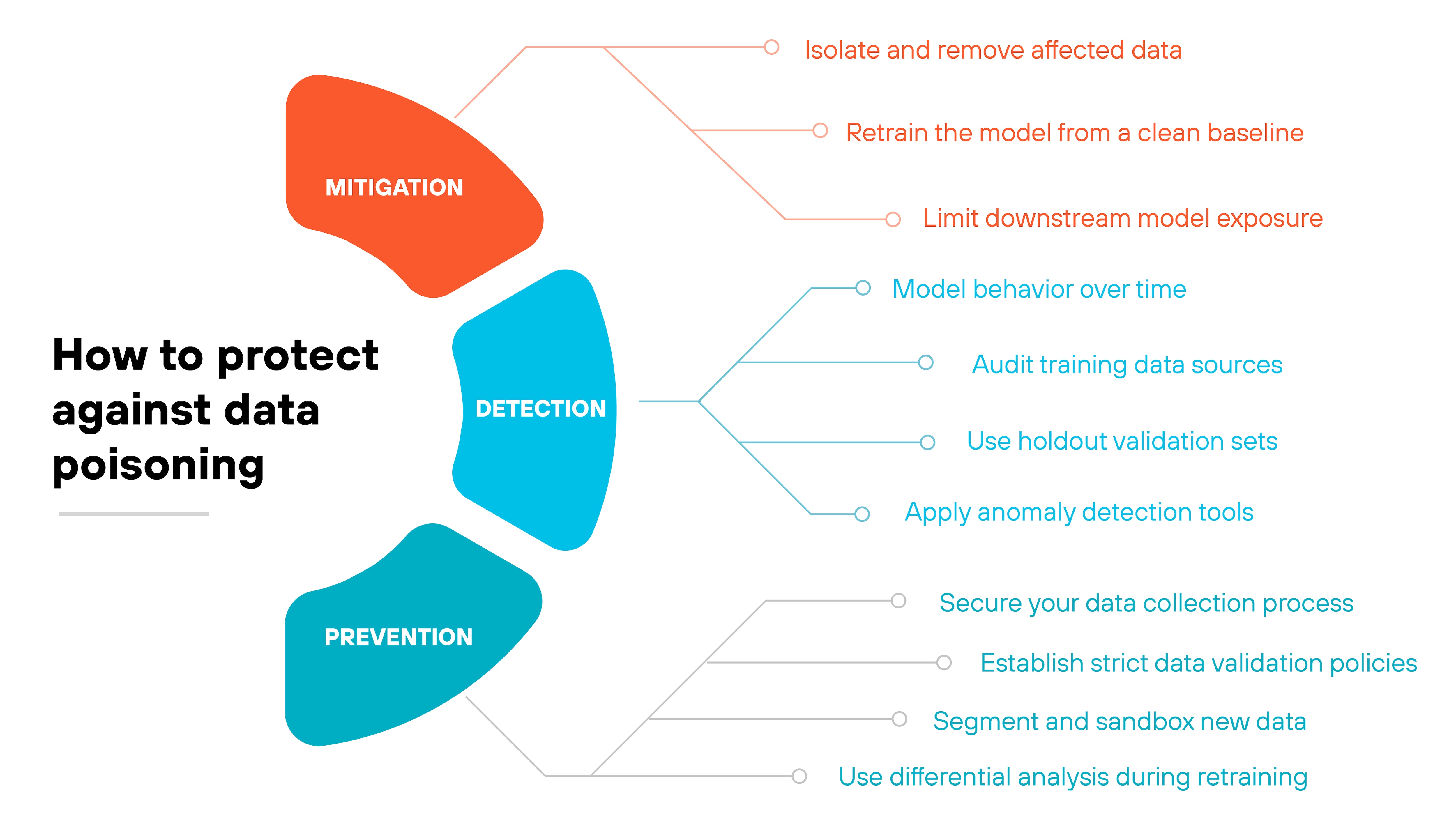
Data poisoning isn't always easy to detect. And once a model has been trained on compromised data, the damage can be hard to undo.
Which means the best protection involves a layered approach across detection, mitigation, and prevention.
Let's break each one down.
Detection
Detecting data poisoning requires behavioral analysis, model validation, and careful inspection of training inputs.
Here's how to approach it:
- Monitor model behavior over time
- Track for signs that model outputs are drifting or becoming inconsistent
- Look for reduced accuracy in specific scenarios
- Check if the model fails disproportionately on edge cases or adversarial inputs.
- Track for hallucinated or inconsistent completions in GenAI applications (e.g., summarization, Q&A, or code generation)
- Watch for new or unusual prediction patterns
Tip:Compare behavior across retraining cycles. If small updates lead to large performance shifts, it may signal poisoning. - Audit training data sources
Understand where your data is coming from.- Validate third-party datasets for known risks
- Review RAG sources and fine-tuning sets for untrusted web content or edited documents
- Investigate outlier samples with unusual formatting or labels
- Look for inconsistent metadata or unexplained data duplication
- Use holdout validation sets
Keep known-clean data separate from the training process.- Evaluate model performance against it regularly
- Use it to detect unanticipated behavioral changes
- In GenAI, check for shifts in tone, reasoning quality, or prompt adherence across model updates
- Compare output distributions across training runs
- Apply anomaly detection tools
Some poisoning attempts leave subtle fingerprints in the data.- Use statistical checks to find outliers in feature distributions
- Apply clustering to detect unnatural data groupings
- Consider graph-based techniques to expose suspicious relationships
Tip:Don't just look at individual samples. Look for patterns across samples that suggest coordinated manipulation.
Mitigation
Once poisoning is confirmed—or strongly suspected—the priority is to minimize harm.
Here's how to respond:
- Isolate and remove affected data
Start by identifying and pulling suspect samples.- Focus on inputs tied to degraded model performance
- Check logs for when and how poisoned data was introduced
- Rebuild the training set without high-risk segments
Tip:Always keep backups of earlier training sets. They're essential for comparison, rollback, and identifying when poisoning may have started. - Retrain the model from a clean baseline
Retraining is often necessary to fully remove poisoning effects.- Use verified data with known provenance
- Avoid resuming training from a previously compromised checkpoint
- Validate intermediate outputs as training progresses
Tip:If full retraining isn't feasible, consider targeted fine-tuning using clean, domain-specific data. - Limit downstream model exposure
While recovery is in progress, limit high-risk uses of the affected model.- Pause automated decision-making where possible
- Add safeguards or human review to model outputs
- Temporarily disable exposure of affected RAG corpora or fine-tuning endpoints
- Notify internal stakeholders of limitations
Prevention
The most effective defense is to stop poisoned data from entering your pipeline.
Here's how to strengthen your controls:
- Secure your data collection process
Treat training data like code or infrastructure.- Use authenticated APIs and encrypted channels
- Restrict who can submit or modify training inputs
- Use access controls and review policies for updating GenAI content sources, such as embeddings or retrieval indexes
- Log and audit all data additions or edits
Tip:Avoid scraping uncontrolled sources unless content is filtered and validated. - Establish strict data validation policies
Use automated checks to enforce standards.- Require consistent formatting and labeling
- Check for duplicate entries and metadata anomalies
- Flag unusually influential samples
Tip:Build validation into the pipeline. Not just at ingestion. - Segment and sandbox new data
Keep incoming data separate from production datasets.- Test new inputs in isolated environments
- In RAG-based systems, validate that added documents do not contain malicious prompt structures or redirect behavior
- Evaluate their impact on small-scale models first
- Monitor for unexpected shifts before full integration
Tip:Shadow-train models using experimental data to detect emerging threats early. - Use differential analysis during retraining
Compare outputs before and after data updates.- Look for spikes in model error rates
- Watch for behavioral changes in specific prediction categories
- For GenAI, test known safe prompts before and after updates to verify consistent and secure output generation
- Run adversarial probes to test resilience
Tip:Maintain version control for both data and models. It helps track changes and simplifies rollback.
- How to Secure AI Infrastructure: A Secure by Design Guide
- What Is AI Security Posture Management (AI-SPM)?
Get a complimentary AI Risk Assessment and find out if you're vulnerable to AI-specific attacks like data poisoning.
Get free assessmentA brief history of data poisoning
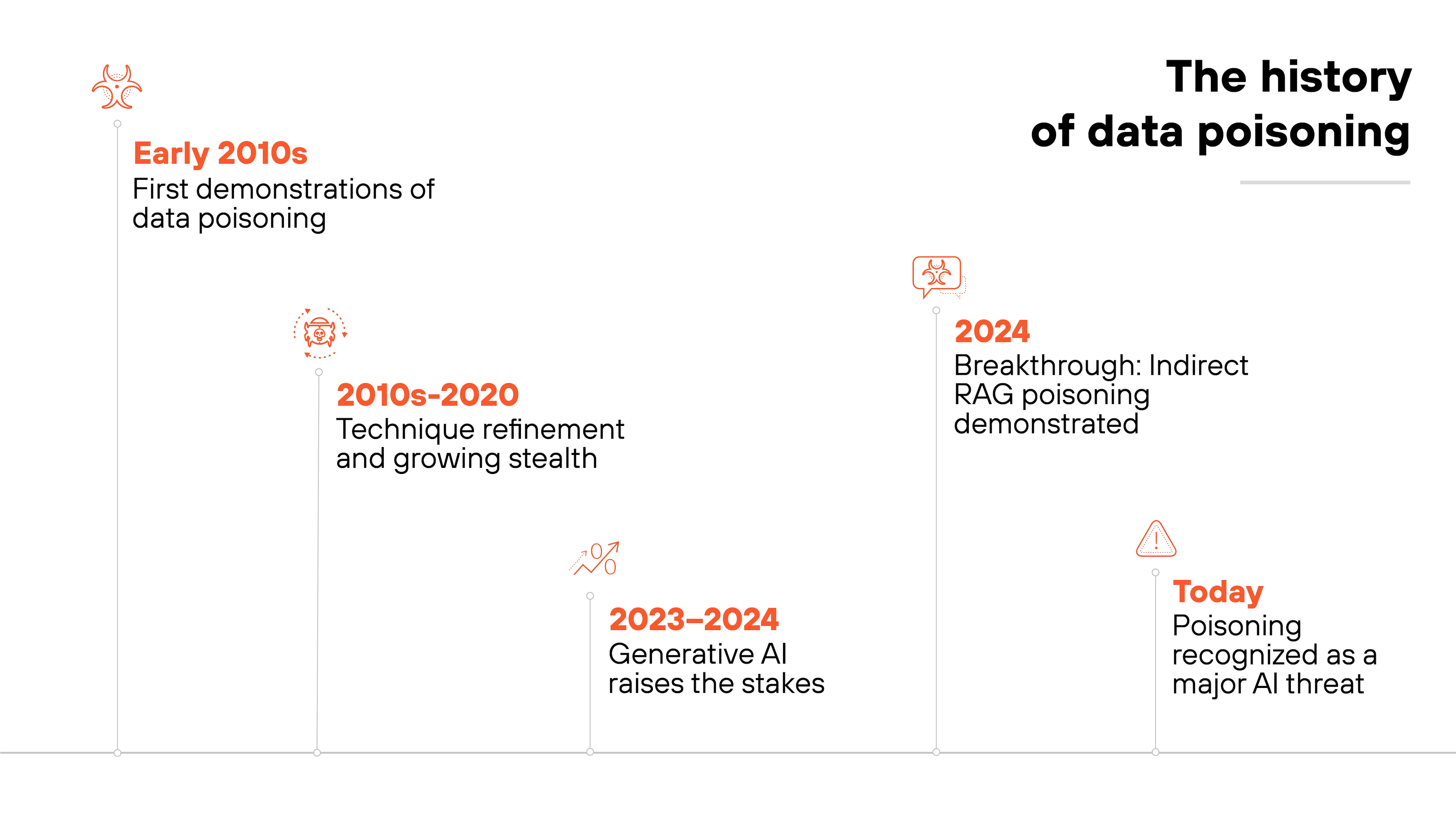
Data poisoning was first explored in the early 2010s, when researchers demonstrated that machine learning models could be manipulated by tampering with their training data. Initial studies focused on simple label flipping and input manipulation, primarily in image classification tasks.
Over the next decade, the field matured. Researchers began developing more stealthy and targeted attacks, including backdoors and clean-label techniques that were harder to detect during evaluation.
But the concern became more urgent with the rise of generative AI.
As LLMs began relying on large-scale public data and fine-tuning pipelines, researchers warned that poisoned inputs could slip in through scraped content or external document corpora. In 2024, academic teams demonstrated indirect poisoning in RAG systems, showing how subtle injections could distort GenAI responses.
Today, data poisoning is recognized as one of the most challenging threats to the integrity of AI models. Especially in production systems that retrain continuously or pull in unvetted external content.
